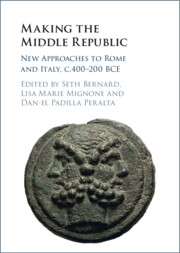Book contents
- Making the Middle Republic
- Making the Middle Republic
- Copyright page
- Contents
- Figures
- Tables
- Charts
- Contributors
- Acknowledgments
- Maps
- 1 Introduction
- Part I Historical Sources
- 2 Italian Descent in Middle Republican Roman Magistrates
- 3 The Long Shadow of Tributum in the Long Fourth Century
- 4 Paying for Conquest in the Early Middle Republic
- 5 Building up Slaveries in Ancient Italy and the Central Sudan
- Part II Material Sources
- Part III Architecture and Art
- Conclusion
- Bibliography
- Index
3 - The Long Shadow of Tributum in the Long Fourth Century
from Part I - Historical Sources
Published online by Cambridge University Press: 20 April 2023
- Making the Middle Republic
- Making the Middle Republic
- Copyright page
- Contents
- Figures
- Tables
- Charts
- Contributors
- Acknowledgments
- Maps
- 1 Introduction
- Part I Historical Sources
- 2 Italian Descent in Middle Republican Roman Magistrates
- 3 The Long Shadow of Tributum in the Long Fourth Century
- 4 Paying for Conquest in the Early Middle Republic
- 5 Building up Slaveries in Ancient Italy and the Central Sudan
- Part II Material Sources
- Part III Architecture and Art
- Conclusion
- Bibliography
- Index
Summary
An underappreciated difference between fifth- and fourth-century Rome was the emergence of stipendium and tributum (military pay and the land tax to fund it). Encompassing every citizen landowner and soldier, stipendium and tributum likely involved more people than any other civic institution at Rome. Moreover, this fiscal system changed the way in which Rome operated. It created a set of tasks that needed to be completed; it then instituted a new set of roles to complete those tasks; then it elevated a set of people in order to fill those roles; and finally those people developed new tactics to derive maximum benefit from their new functions. The key stakeholders in all this were the tribuni aerarii, who operated the system in local areas across the countryside. Though poorly attested in the extant sources, these men had the ability to control the smooth operations of the war machine. They promptly realized that they could hold the fiscal system hostage to extract political concessions. The exclusive rule of Rome’s patrician leaders, now reliant on plebeians to pay and collect taxes, was doomed.
- Type
- Chapter
- Information
- Making the Middle RepublicNew Approaches to Rome and Italy, c.400-200 BCE, pp. 38 - 63Publisher: Cambridge University PressPrint publication year: 2023
- 1
- Cited by



